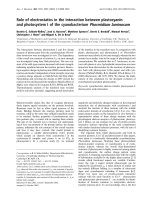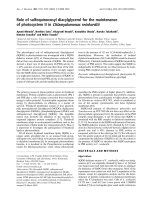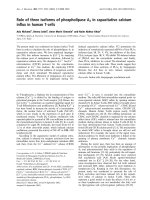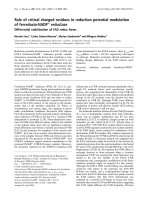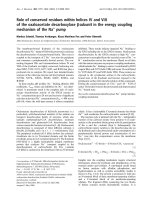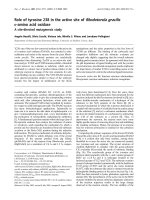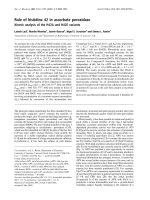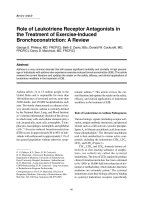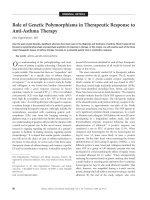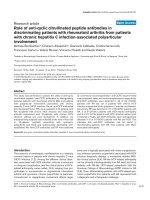Báo cáo y học: "Role of Genetic Polymorphisms in Therapeutic Response to Anti-Asthma Therapy" pot
Bạn đang xem bản rút gọn của tài liệu. Xem và tải ngay bản đầy đủ của tài liệu tại đây (114.07 KB, 3 trang )
ORIGINAL ARTICLE
Role of Genetic Polymorphisms in Therapeutic Response to
Anti-Asthma Therapy
John Oppenheimer, MD
Over the past several decades, significant advances have been seen in the diagnosis and treatment of asthma. Recent research has
focused on potential phenotypic and genotypic predictors of response to therapy. In this review, we will examine each of the three
major therapeutic classes of asthma therapy, focusing on a potential genetic clue to medication response.
Key words: asthma, genetic polymorphisms
O
ur understanding of the pathophysiology and treat-
ment of asthma is quickly advancing. Clinicians have
long understood that asthmatic patients’ response to therapy
is quite variable. This means that there are ‘‘responders’’ and
‘‘nonresponders’’ to a specific class of asthma therapy.
Several recent studies have highlighted phenotypic indicators
of response.
1,2
As an example, in a recent study by Szefler
and colleagues, it was found that baseline characteristics
associated with a good response (increase in forced
expiratory volume in 1 second [FEV
1
] . 15%) to an inhaled
corticosteroid (ICS) were high exhaled nitric oxide (eNO)
level, high b2 reversibility, and a low FEV to forced vital
capacity ratio.
1
An exciting direction with regard to response
to asthma therapy is the potential role of a patient’s genetics
in determining therapeutic response. Although, initially, the
nomenclature associated with examining genetic poly-
morphisms (GPs) may seem like bringing meaning to
alphabet soup, it is quite likely that further advancement in
our understanding of genetics will provide the clinician with
a useful tool in patient care. In the case of cancer, intensive
research is ongoing regarding the evaluation of a patient’s
genetics to facilitate in making decisions regarding specific
chemotherapy.
3
It is hoped that similar genetic considera-
tion will aid in the choice of class of asthma medication in
the future. In this article, we review each of the three major
therapeutic classes of asthma therapy and examine a specific
GP and its contribution to response. It should be noted that
several GPs have been identified for each of these therapeutic
classes; however, examination of all would be beyond the
scope of this review.
The most extensively studied GP in therapeutic asthma
response involves the b
2
agonist receptor. The b
2
receptor
belongs to the G protein–coupled receptor superfamily,
which contains 413 amino acids and was cloned in 1987.
4
Since then, several single nucleotide polymorphisms (SNPs)
have been identified, including Gly16, Ile164, and Glu27.
These have been reviewed in detail elsewhere.
5
The majority
of studies indicate that the Gly16 SNP appears to carry the
greatest potential clinical impact. The wild genetic makeup
of the sixteenth amino acid position of the b
2
receptor is Gly-
Gly; however, in approximately one-sixth of the North
American population, Arg-Arg is seen. This SNP appears to
carry significant potential clinical consequences. In a study
by Martinez and colleagues, 269 children who were b2 naive,
participating in a longitudinal asthma study, had their
bronchodilator response measured following the acute
administration of albuterol.
6
A positive response was
considered a rise in FEV
1
of greater than 15.3%. When
compared with homozygotes for Gly-16, homozygotes for
Arg-16 were 5.3 times more likely to have a positive
response. On the other hand, when examining the chronic
administration of short-acting b agonists (SABAs), a very
different picture is seen. Israel and colleagues examined the
same SNP in a group of 190 asthmatic patients who had
participated in a trial examining the effects of regular versus
as-needed albuterol for 16 weeks.
7
When retrospectively
analyzing the response based on genetic makeup, they found
a small decline in morning peak expiratory flow in patients
homozygous for Arg-16 who used albuterol regularly. This
effect, however, was magnified during a 4-week run-out
period, during which all subjects returned to using as-needed
albuterol. By the end of the study, subjects who were
John Oppenheimer: Pulmonary and Allergy Associates, Summit, NJ;
Department of Internal Medicine, New Jersey Medical School, Newark,
NJ.
Correspondence to: Dr. John Oppenheimer, Pulmonary and Allergy
Associates, 1 Springfield Avenue, Summit, NJ 07901; e-mail: nnilopp@
oprorline.net.
DOI 10.2310/7480.2007.00003
50 Allergy, Asthma, and Clinical Immunology, Vol 3, No 2 (Summer), 2007: pp 50–52
homozygous for Arg-16 who had regularly used albuterol
had a morning peak expiratory flow of 30.5 6 12.1 L/min
lower (p 5 .012) than subjects with a similar SNP who had
used albuterol on an as-needed basis. At the same time, there
was no such decline in peak flows with regular use of
albuterol in patients who were homozygous for Gly-16.
When the same group prospectively studied the
response to chronic administration (16 weeks) of albuterol
stratified by genotype, they demonstrated that whereas the
Arg-Arg group suffered a small reduction, the Gly-Gly
group demonstrated a rise in peak flows.
8
The resultant
difference was 24 L/min (p 5 .0003). Similar genotype-
specific attributable effects were seen in FEV
1
, symptom
control, and use of supplemental reliever medicine.
Taylor and colleagues performed retrospective analysis of
the relationship between GP of the b2 receptor and clinical
outcomes in a placebo-controlled, crossover trial examining
the use of regularly scheduled albuterol or salmeterol in a
group of 115 mild to moderate asthmatics (24 weeks).
9
Once
again, chronic use of albuterol in the Arg-Arg group
demonstrated a negative effect. Specifically, exacerbation
rates were higher in the Arg-Arg group when using chronic
albuterol (p 5 .005); however, there appeared to be no such
increase with chronic administration of salmeterol.
These findings appear to indicate that the SNP effect was
limited to SABAs only, until a recent publication by
Weschsler and colleagues indicated that long-acting b
agonists (LABAs) may also be affected by a patient’s genetic
makeup.
10
In their study, retrospective re-evaluation of the
Salmeterol or Corticosteroids (SOCS) and Salmeterol 6
Inhaled Corticosteroids (SLIC) trial data were analyzed
based on GP. The SOCS study examined a group of
asthmatic patients with FEV
1
. 80% who were randomized
to receive salmeterol or an ICS (triamcinolone) for 16
weeks.
11
In this study, they demonstrated higher exacerba-
tion rates in the LABA versus ICS group. The SLIC study
examined a group of steroid-naive asthmatics with baseline
FEV
1
# 80% of predicted, demonstrating the ability of
LABA to reduce the dose of ICS without an increase in the
exacerbation rate.
12
When these studies were reanalyzed
stratified to SNP, both the SOCS and SLIC trials demon-
strated a significant fall in Peak Expiratory Flow Rate (PEFR)
in the Arg-Arg group, whereas a rise was seen in the Gly-Gly
group (p 5 .005 and .048, respectively).
These very interesting data should be viewed as
preliminary evidence in that the study does have limitations.
Beyond the fact that it is retrospective evaluation, it also
involves a very small sample size. It has, however, catalyzed
an ongoing prospective study employing larger numbers of
subjects stratified by SNP, entitled the LARGE study (Long
Acting Beta Response by Genotype), in an attempt to answer
the question of the role of SNPs and response to LABAs.
Several studies have demonstrated a distribution of
therapeutic response to both ICS and leukotriene modifier
(LTM).
2,13
This phenomenon is exemplified in a study by
Baumgartner and colleagues, who performed a 6-week
Double-blind placebo control (DBPC) trial in 730 adult
asthmatics comparing the effectiveness of montelukast with
inhaled beclomethasone by assessing improvement in asthma
control days as a surrogate to response.
2
Although the authors
demonstrated significant concordance in response (89%),
they also demonstrated variability in response, with a group
of subjects who had no improvement with therapy.
Zeiger and colleagues showed similar variability in response
to either an ICS or LTM and further assessed potential
phenotypic indicators of response using asthma control days as
a surrogate of response in a group of children.
13
In this
crossover study, they found that a greater response to ICS
versus LTM was associated with elevated baseline eNO, greater
use of b
2
agonists, and more positive skin test responses.
When one examines the literature regarding potential
SNP and response to LTM, two loci are of interest. The
first is 5-lipoxygenase (5-LO) promoter and the second is
leukotriene C
4
synthase (LTC
4
S). Although there has been
some interesting work demonstrating the potential import
of 5LO SNPs,
14
we will focus our discussion on LTC
4
S.
This enzyme controls cysteinyl leukotriene biosynthesis. It
exists in two common alleles distinguished by an A or C
transversion at a site 444 nucleotides upstream from the
translational start. In a study by Sanek and colleagues,
subjects with aspirin-intolerant asthma (an entity asso-
ciated with increase in leukotriene production) were more
commonly of the 444C allele.
15
This finding has not been
universal, however, as a study by Kedda and colleagues was
unable to demonstrate a similar association.
16
To attempt to understand this SNP’s association with
medicine response, Sampson and colleagues examined
LTC
4
S SNP and clinical response to the LTM zafirlukast by
examining 23 adult asthmatics who were uncontrolled
despite aggressive anti-asthma therapeutic intervention.
17
At baseline, all subjects were receiving ICS; 10 were receiving
oral corticosteroids, 14 LABA, 4 theophylline, and 1
cyclosporine. During the study period, all subjects abstained
from all medications except ICS and rescue SABA. Despite
the fact that this study was of an open design as all subjects
received 20 mg of zafirlukast twice daily for 2 weeks,
investigators were blinded to patient genotype. Although the
results did not reach significance (p 5 .1), they were quite
provoking. The group with a wild phenotype (A/A)
demonstrated an 18% reduction in FEV
1
, whereas the
Oppenheimer, Role of Genetic Polymorphisms in Therapeutic Response to Anti-Asthma Therapy 51
variant (C/C and C/A) demonstrated a 12% rise in FEV
1
.
Overall, this study intimates a potential role in response and
reinforces the need for further large-scale prospective studies.
Corticosteroid SNPs have been the least intensively
studied thus far; however, some recent data speak to potential
clues in ICS response. Tantisira and colleagues investigated
the genetic contribution to the variation in response to
ICS therapy in asthma by assessing the association of change
in lung function from candidate genes crucial to the bio-
logic actions of corticosteroids.
18
This was accomplished
by retrospectively examining three independent clinical
trials using ICS as the primary therapeutic intervention.
Variation in one gene, corticotrophin-releasing hor-
mone receptor 1 (CRHR1), was consistently associated
with enhanced response. In each of the studies, subjects
with the GAT/GAT homozygous haplotype demonstrated
greater improvement in mean FEV
1
than subjects with
other haplotypes. CRHR1 is the predominant corticotro-
phin-releasing hormone (CRH) receptor in the pituitary
gland, mediating release of adrenocorticotropic hormone
and the catecholaminergic response to CRH. As decreased
expression or function of CRHR1 would be expected to
diminish cortisol secretion in response to inflammation,
one can imagine the impact on asthma associated with
polymorphisms in this gene and the subsequent greater
response to exogenous corticosteroids.
Although the data presented in this review are encour-
aging, it is quite obvious that the consistency of the SNP
effect is far from universal. These inconsistencies may be a
result of the fact that not one SNP but multiple genetic loci
may play a simultaneous role in response to pharmacother-
apy. Future research regarding the mysteries of asthma will
focus on not only phenotypic indicators but also better
understanding of potential contribution of a patient’s
genetic secrets. Although our research in these genetic clues
is primordial and unraveling this genetic mystery appears to
be a daunting task, it is a worthwhile one, as once
understood, we may be able to rely on a patient’s genetics
to aid in choosing the most appropriate therapy. As
clinicians attempting to stay current in the evolving science
of asthma, we must continue to follow the very exciting
literature regarding potential phenotypic and genotypic
indicators of response to therapy because one or the
combination of both of these tools will likely be a clue to a
patient’s response to therapy.
References
1. Szefler S, Martin RJ, King TS, et al. Significant variability in
response to inhaled corticosteroids for persistent asthma. J Allergy
Clin Immunol 2002;109:410–8.
2. Baumgartner RA, Martinez G, Edelman JM, et al. Distribution of
therapeutic response in asthma control between oral montelukast
and inhaled beclomethasone. Eur Respir J 2003;21:123–8.
3. Fourie J, Diasio RB. Pharmacogenetics. In: Chabner BA, Longo DL,
editors. Cancer chemotherapy and biotherapy: principles and
practice. 4th ed. Philadelphia: Lippincott Williams and Wilkins;
2006. p. 529–48.
4. Kobilka BK, Dixon RA, Fielle HG, et al. cDNA for the human b2-
adrenergic receptor: a protein with multiple membrane-spanning
domains and encoding by a gene whose chromosomal location is
shared with that of the receptor for platelet-derived growth factor.
Proc Natl Acad Sci U S A 1987;84:46–50.
5. Green SA, Turki J, Hall IP, Ligget SB. Implications of genetic
variability of human B2-adrenergic receptor structure. Pulm
Pharmacol 1995;8:1–10.
6. Martinez FD, Graves PE, Baldini M, et al. Association between
genetic polymorphisms of the beta 2-adrenoreceptor and response
to albuterol in children with and without a history of wheezing. J
Clin Invest 1997;100:3184–8.
7. Israel E, Drazen JM, Liggett SB, et al. The effect of polymorphisms
of the beta2-adrenergic receptor on the response to regular use of
albuterol in asthma. Am J Respir Crit Care Med 2000;162:75–80.
8. Israel E, Chinchilli VM, Ford JG, et al. Use of regularly scheduled
albuterol treatment in asthma: genotype-stratified, randomised,
placebo-controlled cross-over trial. Lancet 2004;364:1505–12.
9. Taylor DR, Drazen JM, Herbison GP, et al. Asthma exacerbations
during long term b-agonist use: influence of b2adrenoceptor
polymorphism. Thorax 2000;55:762–7.
10. Weschsler ME, Lehman E, Lazarus SC, et al. b-adrenergic receptor
polymorphisms and response to salmeterol. Am J Respir Crit Care
Med 2006;173:519–26.
11. Lazarus S, Boushey HA, Fahy JV, et al. Long-acting b
2
-agonist
monotherapy vs continued therapy with inhaled corticosteroids in
patients with persistent asthma: a randomized controlled trial.
JAMA 2001;285:2583–93.
12. Lemanske RF Jr, Sorkness CA, Mauger EA, et al. Inhaled
corticosteroid reduction and elimination in patients with persistent
asthma receiving salmeterol: a randomized controlled trial. JAMA
2001;285:2594–603.
13. Zeiger RS, Szefler SJ, Phillips BR, et al. Repsonse profiles to
fluticasone and montelukast in mild-to-moderate persistent
childhood asthma. J Allergy Clin Immunol 2006;117:45–52.
14. Drazen J, Yandava C, Dube L, et al. Pharmacogenetic association
between ALOX5 promoter genotype and the response to anti-
asthma treatment. Nat Genet 1999;22:168–70.
15. Sanak M, Pierzhalska M, Bazan-Socha S, Szczeklik A. Enhanced
expression of leukotriene C4 synthase due to overactive transcrip-
tion of an allelic variant associated with aspirin-intolerant asthma
Am J Respir Cell Mol Bio 2000;23:290–6.
16. Kedda M, Shi J, Duffy D, et al. Characterization of two
polymorphisms in the leukotriene C4 synthase gene in an
Australian population of subjects with mild, moderate and severe
asthma. J Allergy Clin Immunol 2004;1134:889–95.
17. Sampson AP, Siddiqui S, Buchanan D, et al. Variant LTC4 synthase
allele modifies cysteinyl leukotriene synthesis in eosinophils and
predicts clinical response to zafirlukast. Thorax 2000;55:S28–31.
18. Tantisira KG, Lake S, Silverman ES, et al. Corticosteroid
pharmacogenetics: association of sequence variants in CRHR1
with improved lung function in asthmatics treated with inhaled
corticosteroids. Hum Mol Genet 2004;13:1353–9.
52 Allergy, Asthma, and Clinical Immunology, Volume 3, Number 2, 2007
